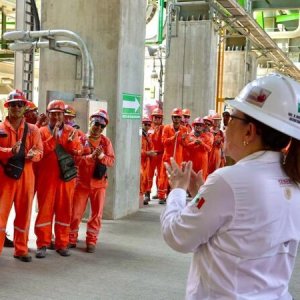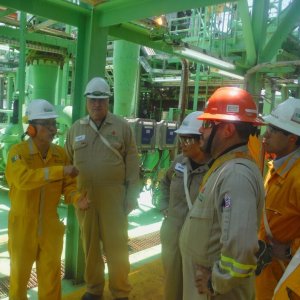
Balancing Local Talent with Expertise from Abroad
As part of its ongoing transition to a productive enterprise of the state, PEMEX has set itself the goal of operating with a workforce of nearly 111,000 workers in 2018. While the talent exists in the country, with industry newcomers entering, the competition is heating up. PEMEX and IOCs alike are devising talent attraction and retention strategies to make good on their business objectives in Mexico’s oil and gas industry. A quick look at the licensing rounds gives an idea of the human capital requirement that needs to be filled. According to CNH, 113 companies have participated in the licensing rounds so far, of which 73 were awarded 107 blocks out of the 161 blocks tendered, amounting to an allocation area of 88,648.5km2. The 138 committed wells amount to a total investment in work programs of US$4 billion. The particular figure that stands out is that Mexican companies were the main winners of the rounds, with 55 companies awarded one or more blocks. The US is second with 19 companies and Colombia comes in third with five companies. All these companies have taken on the objective of further developing Mexico’s oil and gas production platform and will certainly need the country’s expert petroleum engineers, geologists and geophysicists to do so.
FILLING GENERATIONAL GAPS
In 2014, the Ministry of Energy, in coordination with CONACYT and the Ministry of Education published the Strategic Program of Human Resource Training in Energy. In it, the federal government estimated that from 2015-18, the industry will require an additional 135,000 trained professionals with technical profiles in higher education levels. The program also estimated that PEMEX would have to replace 29,307 professionals eligible for retirement. “Companies are trying to find the right balance between experienced staff who have left PEMEX or who lost their jobs in 2014’s oil price downturn and newly-graduated university students. If we can mix that talent in the right way we will have a very successful Energy Reform,” says Germán Pineda, President of the Mexican Association for Human Resources in the Oil Industry (ARHIP).
During ONEXPO 2018, Minister of Energy Pedro Joaquín Coldwell highlighted that as nine licensing rounds have concluded, including three farmout contracts from PEMEX and 104 contracts awarded to 73 new companies, estimated investments are close to US$161 billion. This means the creation of an estimated 900,000 direct and indirect jobs in specialized, technical positions throughout the duration of the contracts. Replacing tenured officials with valuable experience and knowledge is no easy feat, but nor is adapting them to the new face of the industry. As new players from mature oil and gas industries come onto the scene, new qualifications and certifications will be required to inject increased dynamism and productivity in Mexico’s oil and gas industry. PEMEX will need to closely coordinate with academia to draft training programs both for new recruits and senior officials and adapt their knowledge and expertise to the qualifications required. In October 2017, the Ministry of Energy, Mexico’s Engineering Academy (AIM), ITESM and CONACYT joined forces to create the Energy Talent Observatory, with a joint investment of MX$49 million. Emulating a similar measure deployed by Canada’s University of Calgary, the project seeks to map out the expected investment levels in each of the industry’s sectors, from hydrocarbons to renewables and match them with the required human capital. The first stage of the observatory will be to study these two variables over an 18-month period, after which imbalances between investments and human talent will be monitored and corrected up until 2023. It will also provide a platform for academia to adjust training programs across all levels of specialization, tailored to the industry’s demands.
LOCAL CONTENT PROVISIONS AND NAFTA
Based on the regulatory framework, it falls upon the Ministry of Economy to determine how Mexico’s private sector will comply with its local content provisions. Based on the aforementioned regulatory framework, the concepts that qualify in complying with local content include contracted goods and services, skilled national workforce, training of said national workforce, investments in local and regional infrastructure and technology transfer. Both operators and direct suppliers are obligated to comply. Failure to do so can generate fines from MX$600,000 to MX$12 million, according to a PwC report on local content for the hydrocarbons and electricity sectors. For E&P activities, operators and suppliers need to prove 25 percent of local content in their activities, set to increase to 35 percent by 2025. Local talent can provide the bedrock to meet local content requirements and is expected to take the lion’s share of the requirement to ensure compliance.
NAFTA renegotiations could have a significant impact over how Mexico characterizes local content and can provide the oil and gas industry a balance between qualified local personnel and the expertise, experience and technology of its northern neighbors. “It seems like the vision is shifting toward regional energy security and regional human capital content,” says Miguel Marmolejo, External Strategic Researcher in Energy Affairs at Access to Energy. “This small change could represent an increase in trading of energy sources and also human capital.” Marmolejo considers allowing regional objectives to supersede national rules could give the North American region a reinforced position against economies such as China and India.
STRENGTHENING VALUE CHAIN LINKS A value chain is only as strong as its weakest link. Unlocking new areas in the oil and gas industry, such as logistics, production and the sale of oil means human capital is required to fill roles outside PEMEX. “Companies need to do their own logistics, their own storage and sell the product themselves. This led us to create new positions, new profiles and to seek to train people in the labor market who do not yet exist,” says Oscar González, Board Member of the Mexican Association for the Management of Human Resources (AMEDIRH). He says human resources departments could try knowledge transfer schemes to make the most out of PEMEX retirees before they leave. “We are looking for people within companies from other sectors that have all the necessary expertise and we are combining them with people leaving PEMEX who have a great deal of experience,” he explains. “Once gathered, we launch a cross-training of sorts in which the people from PEMEX and the people from outside the oil and gas industry are trained together, resulting in an interesting mix,” says González. Training skilled, technical and experienced professionals for the offshore sector is set to become the most challenging in the industry, González adds. “We are talking about periods of five to 10 years because people cannot have important operational jobs if they do not pass a complete cycle of training, with years of working on drilling crews,” he says. “For companies, this is a double cost.”
Coordination between government agencies, the private sector and academia will prove critical over the near future to align talent supply with demand. “The Ministry of Energy and CONACYT already have some programs and they have been investing aggressively in the education of people at universities in cities such as Aberdeen and Houston,” says Pineda. “Of course, the government is interested in supporting these efforts but it is time for companies to also invest in their main asset: their employees. ”
TURNING CHALLENGE INTO OPPORTUNITY
Providing Mexico’s oil and gas industry with qualified human capital is more of a marathon than a sprint, especially considering the inherent long-term component of oil and gas developments. It also means the industry will increasingly require human capital management solutions, creating a business boom for human resourcesbased business in the country. “There are over 60 new operators who are just getting started in Mexico, all in different phases of hiring,” says Guido Van Der Zwet, General Manager Americas of HR firm iPS Powerful People. “Some are active and hiring at a faster pace than others. Of course, there is more development with onshore and shallow-water operators. With deepwater operators, hiring is a bit slower but it is also progressing,” he adds.
















